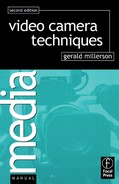Strictly speaking, a lens only gives an absolutely sharp image for subjects at the distance to which it is focused (the focused plane). In practice however, things that are nearer or further away may still look reasonably sharp. The depth of this ‘sharpness zone’, can vary considerably; from a few centimeters to infinity (a)! Outside this zone, which is called the depth of field, subjects appear increasingly soft-focused.
What affects the depth of field?
The depth of field changes whenever you alter –
• The focused distance – i.e. how far away you are focused.
• The lens’s focal length – i.e. the zoom setting (hence the lens angle).
• The lens aperture – i.e. the f-stop you are working at.
Change any of these, and this sharpness zone gets deeper or shallower!
Does this effect really matter?
In a long shot, the focused zone can be considerable; But take a big closeup of something nearby, and you may not be able to get the entire subject in focus! When a subject is textured or patterned, this fall off in sharpness will be very obvious; but where surfaces are plain, some defocusing is not always obvious.
Depth of field can become quite shallow when you use the zoom lens set to a long focal length (long focus lens; narrow lens angle) – i.e. when ‘zoomed right in’, particularly with a large lens aperture (a large stop; e.g. f/1.9). Accurate focusing may be difficult, especially when shooting close-ups.
Use the same zoom lens set to a short focal length (wide lens angle) – i.e. ‘zoomed right out’, and particularly when it has a small lens aperture (stopped right down; e.g. f/16), everything in the picture will look sharp.
As the camera moves, or the subject distance changes, you may need to re-adjust focus. Whether focusing is critical or not depends on the depth of field available and the detail visible. In a close-up, even slight subject movement may necessitate refocusing. In a longer shot, quite widespread movements may still remain within the focused zone.
Many narrow-angle/long-focus lenses (e.g. of 5° or less) cannot focus sharply on anything closer than a meter or so away (its minimum focusing distance – MFD). For extremely close shots, you will need to use the zoom lens’ macro setting, or fit a positive supplementary lens attachment.
Types of focus control
1. Spoked capstan knob. 2. Twist grip. 3. Camera focus handle.
Depth of field
Within the depth of field a lens subjects appear sharp, although maximum sharpness occurs at the focused distance (focused plane), FD. Outside this zone (nearer than Dn or further away than Df) sharpness falls off rapidly and subjects become defocused.

